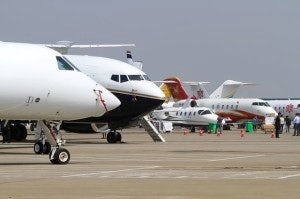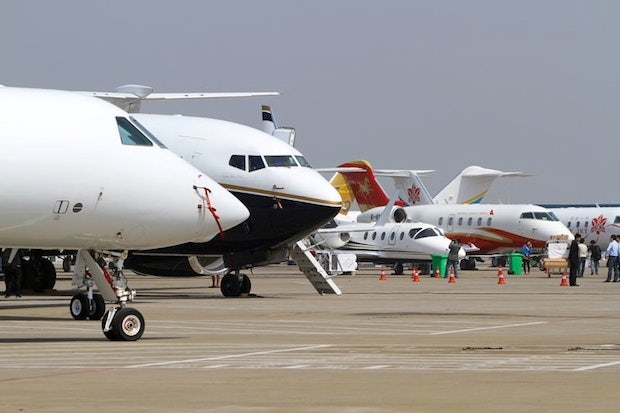Aviation Representative Says Flying In China Easier Than Ever Before#

The ABACE 2013 static display, which hosted 33 aircraft. (David McIntosh/AIN)
This article originally appeared on AIN online as part of its coverage of the Asian Business Aviation Conference and Exhibition (ABACE).
After spending many years introducing business jets to Chinese owners and founding his own company in 2010 to serve the rapidly evolving market for business aviation in China, Jason Liao has developed a unique perspective about general aviation operations in China. He is also the U.S. National Business Aviation Association’s chief representative in Asia.
While it may seem that flying and operating general aviation aircraft (all except military and commercial aircraft, including business jets) in China is still extremely difficult, Liao begs to differ. General aviation in China is growing inexorably, he said, and “the key is that nobody can stop it,” he told
AIN#
. Flying in China is already much easier than it was 15 years ago, he explained, and China’s new investors and entrepreneurs have taken to general aviation in a big way. They also see tremendous opportunities to build businesses with general aviation aircraft.
One third of China’s airspace is under an experimental phase of opening up for general aviation flying, he said, although China’s military still has control over all airspace. “Lots of people love to fly,” he said, “and they have a lot of money. People go to the U.S.or Europe and they want to have that sort of freedom to fly [in Asia] as well.”
Liao believes that China’s military authorities will allow most airspace below 1,000 meters to be available for flights without prior permission, which should help light aircraft and helicopter operators, especially flight schools. But now, flight schools in many parts of China are operating within zones where they are allowed to fly relatively freely. Eventually, Liao added, the military may allow expanded use of airspace when aircraft are equipped with ADS-B OUT equipment, which enables aircraft to be tracked easily without the need to install expensive radar systems.
China is building about 10 to 15 new airports every year, Liao said, although that isn’t very many, considering that a huge country like China has only about 300 airports now. “That’s a problem we’re working on,” he said. And part of the problem is that cities seem to want big airports to attract airlines and don’t understand that an airport acts as a utility, attracting new business. “You provide an airport so other people can make money,” he said.
Liao is encouraged to see so many Chinese companies getting into the aircraft manufacturing business and that the government encourages these moves. He would like to see more foreigners come to China, not to build their own businesses, but to offer their skills to Chinese aviation business owners. “What we need is expertise,” he explained. Chinese companies don’t need to reinvent the wheel but could benefit from the knowledge gained in the U.S. after more than 100 years of aviation infrastructure development.
As the ABACE show grows, Liao pointed out that it’s been only three years since he met with NBAA officials to relaunch ABACE in Shanghai. In 2010, the EBACE show in Europe celebrated its 10th anniversary. By the time ABACE reaches its five-year anniversary in three years, Liao wants the Shanghai show to be just as big as EBACE at 10 years. “We’re getting there,” he said. “These are very exciting times.”
